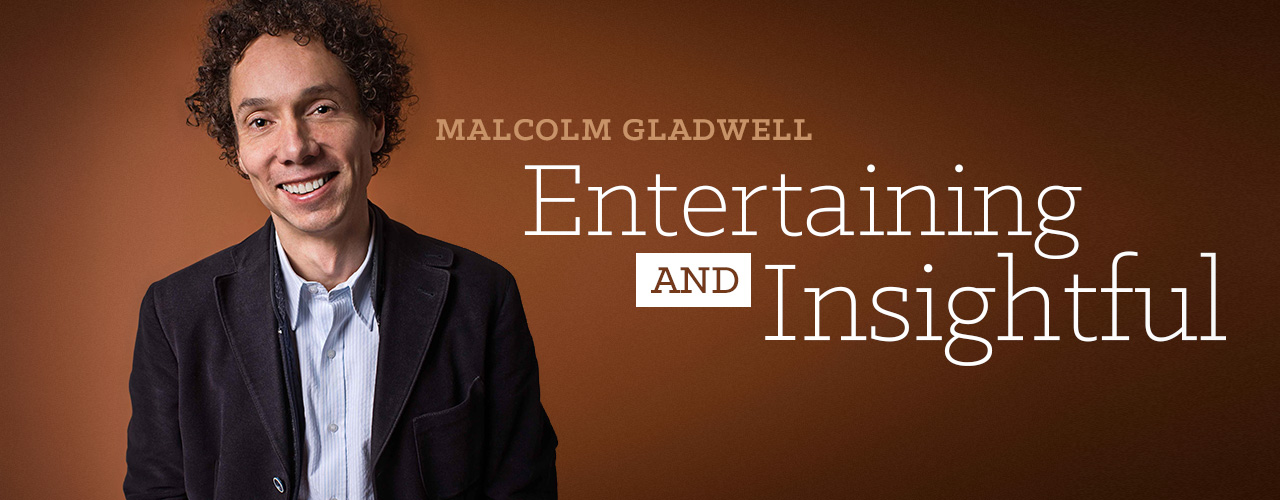
Sometimes truth is stranger than fiction.
Certainly that is the case time and time again in Malcolm Gladwell’s invariably entertaining books. Looking at the world through Gladwellian glasses means homing in on details people don’t often think about. It means asking big and small questions to get at the truth of the matter. It means reconsidering established truths.
One of my favorite examples of Gladwell’s analysis comes from his third book, Outliers. Gladwell presents us with the list of the 75 richest people in the history of the world. This is a list historians have put together and includes everyone from the Pharaohs of ancient Egypt to Bill Gates. Of that list, Gladwell notes, 14 were born in a nine-year span in the 19th-century America. Here Gladwell asks a small question with a big answer. Why is that? Why are nearly 20% of the people on that list so close in age and from the same country?
The answer is opportunity. John D. Rockefeller (Titan: The Life of John D. Rockefeller), J.P. Morgan, Marshall Field, Fredrick Weyerhaeuser, and nine others were all born between the years 1831 and 1840. Because of the economics of the Civil War and postwar periods followed by the boom of the expanding railways and advent of Wall Street, these 14 were perfectly poised to reshape America and her economy. Those born a decade before were too old, stodgy, and set in their ways. Those born a decade later hadn’t come into their own yet. It always makes me wonder what the next auspicious generation will be.
Of course Gladwell doesn’t lead us to believe success is all about luck. In the same chapter that deals with the above subject he defines the now-famous 10,000-hour rule. This is the amount of time Gladwell believes it takes go from amateur to master. It is also the secret to Bill Gates’s as well as The Beatles’ prosperity. Because Bill Gates had access to a computer and began programming when he was 13 years old at the University of Washington—at a time when this was still unusual—he quickly rose to master computer programming. This sets him aside from many other highly intelligent, ambitious people of his generation who did not become multibillionaires. The Beatles played more than 1,200 shows in Hamburg between 1960 and 1964. There, they developed the skills necessary to become one of the world’s all-time greatest bands at such a young age. Gladwell points out that it takes only 20 hours a week for 10 years to achieve mastery level. In theory, anyone can do it. Gladwell admits that he himself spent about 10,000 hours writing for The American Spectator and then The Washington Post before becoming a master of his craft.
Gladwell was most recently obsessed with the old story of David and Goliath. This is the eponymous story in his latest book. In classic form, he reconsidered the two famous opponents, digging into the details of the tale. Through his critical approach, Gladwell discovered that David was not the underdog at all—Goliath was. David was fast, nimble, and well practiced with the sling, as he used it to defend his herd against predators. Goliath on the other hand was weighed down by his arm, and specifics of the story indicate that he had trouble seeing. Goliath expected David to come to him in hand-to-hand combat, but that was never David’s intention. It goes to show that life, and the stories we tell, are not always what we think they are. Gladwell fills his book with other such insights, sometimes turning what we think on its head.
But Gladwell doesn’t just concern himself with historical story or lofty anecdotes. He uses data to take on real-life problems. In his first book, The Tipping Point, Gladwell uses epidemiology to approach topics like the drop in crime rate in 1990s. He believes that crime is contagious. In the 1990s in New York City, police started targeting small crimes such as jumping the turnstiles in subways. Gladwell concludes that this directly correlates with a drop in larger crimes. Because, like disease, if crime is contagious, then reducing smaller crimes snuffs out the crime epidemic.
Through all of his data studies, anecdotes, and theories, Malcolm Gladwell remains immensely enjoyable. His writing feels like a conversation (even more so with audiobooks!) and not like a textbook.
What’s your favorite Gladwell anecdote? Let us know in the comment section. Also, check out our Libro.fm Malcolm Gladwell author page, where you’ll find all his audiobooks.
Watch Malcolm Gladwell’s other TED Talks here
Read Malcolm Gladwell’s work at The New Yorker here.
The Tipping Point
By Malcolm Gladwell
Gladwell’s first book, which looks at issues big and small through the lens of epidemiology. Here you’ll find a wide variety of topics from the seemingly inconsequential (shoe trends) to those that affect society as a whole (crime rates).
Blink
By Malcolm Gladwell
We think without thinking. Using scientific evidence, Gladwell examines our biases and hunches that lead to sound decisions.
Outliers
By Malcolm Gladwell
What makes someone successful? Gladwell looks at this question from every angle, from someone’s date of birth to early access to education and technology, distinguishing the most successful people from everyone else.
What the Dog Saw
By Malcolm Gladwell
Gladwell selected 19 of his articles previously published in The New Yorker to fill this book. Topics include the fall of Enron, late bloomers, the variety of spaghetti sauces, and the inventor of the birth-control pill, just to name a few.

David and Goliath
By Malcolm Gladwell
In typical form, Gladwell flips everything we think we know on its head, looking at the stories of underdogs and success. Besides the eponymous Biblical story, Gladwell details Northern Ireland, revenge scenarios, civil rights leaders, and more.
To hear more about Malcolm Gladwell and similar authors, sign up for the Libro.fm newsletter. We’ll send great audiobook news right to your inbox.





